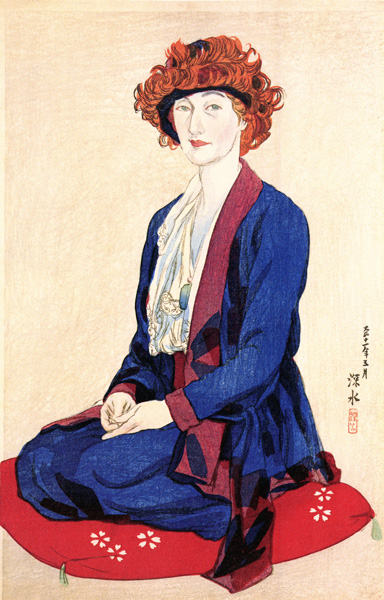
 Elizabeth Keith, considered to be one of the founding artists of the 'shin-hanga' movement, was born in Aberdeenshire, Scotland in 1887, and raised in England. Elizabeth Keith was a self-taught artist that produced drawings and watercolours. There is no record of her having received formal training in the arts. She received little family encouragement in her professional pursuit of art. Elizabeth Keith moved to London with her family in 1898.
Elizabeth Keith, considered to be one of the founding artists of the 'shin-hanga' movement, was born in Aberdeenshire, Scotland in 1887, and raised in England. Elizabeth Keith was a self-taught artist that produced drawings and watercolours. There is no record of her having received formal training in the arts. She received little family encouragement in her professional pursuit of art. Elizabeth Keith moved to London with her family in 1898.
In 1915, at age 28, she went to Japan to visit her younger sister, Elspet ("Jessie"), who was married to J.W. Robertson-Scott, publisher of the Tokyo-based magazine, The New East. Her intended holiday became a stay which lasted nine years. She did watercolours of Japan and Korea. Keith traveled widely, making trips to Korea, China, and the Philippines and throughout Japan. At that time she had never done a woodblock before. Although she did not perform the carving or printing herself, she wanted to have a basic understanding to supervise the process. So for the next two years she learned the Japanese woodblock printmaking technique. Wanting to master the techniques she stayed on in Tokyo studying woodblock printing. Before long her blocks were carved and printed with little aid from Watanabe's artisans.
Watanabe encouraged Keith to work with wood block cutters to translate her watercolours into prints. Elizabeth Keith’s first large scale exhibition of her paintings and watercolors took place in 1919 at the Peers Club, Tokyo. Her art quickly came to the attention of the leading publisher of Shin Hanga art, Shosaburo Watanabe, who convinced Keith to work upon designs for woodcuts. Her first woodblock print, East Gate, Seoul, by Moonlight was published by Watanabe later that year. From her association with Watanabe, she knew the woodblock artists Hasul, Yoshida and (13-2, p. 37) Shinsul.
The great earthquake and fire of Sept. 1, 1923 destroyed most of Watanabe's blocks including his classic reproductions and works in progress. When his studio was destroyed, most of Keith's woodblocks were also lost. Keith returned to England in 1924 where she studied color etching. Keith studied etching techniques in France. She produced etchings as early as 1924 and as late as 1938. Perhaps her finest color etching is shown in the figure on the immediate right, known as "The Chinese Matriarch."
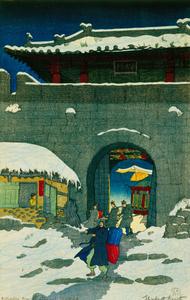
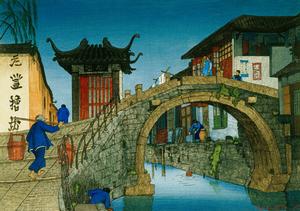 By the time she left Japan in 1924, she had published over a hundred prints with him, and put on successful shows in Japan, London and New York. In 1927 her watercolor entitled, Korean Bride was exhibited at the Royal Academy. In 1932 Keith returned to Japan where her sister, Jessie, helped to promote her works. Her first prints met with great success.
By the time she left Japan in 1924, she had published over a hundred prints with him, and put on successful shows in Japan, London and New York. In 1927 her watercolor entitled, Korean Bride was exhibited at the Royal Academy. In 1932 Keith returned to Japan where her sister, Jessie, helped to promote her works. Her first prints met with great success.
She was back in Asia from 1932 to 1933, during which time she mastered color etching and her sister, Jessie, helped to promote her works. In 1935, she made a last desperate trip to Japan to fill sketchbooks for a projected series of prints realizing the intimations of a war couldn't be ignored. She believed to have produced one hundred woodblock prints and about a dozen color etchings. All of her prints are signed in pencil, following Western customs. Some of her prints were published in numbers of only 30 to 50 copies. In the mid 1930s, she participated in exhibitions in the United States. In 1956, she had a solo exhibition in Tokyo, which included 59 woodblock prints and 8 color etchings. Elizabeth Keith died in 1956. In her lifetime, she had the satisfaction of seeing her prints of Asian life acquired by the British Museum, the Musee Guimet in Paris, the National Gallery of Canada, the Honolulu Academy of Arts, and, as an important part of the Murray Warner collection, the Museum of Art at the University of Oregon.
Keith published Eastern Windows in 1928 and Old Korea in 1946, both English-language books that explored Asian life through reference to her artwork. Elspet Robertson Scott, Keith’s sister, coauthored the latter.
THE ANCIENT TECHNIQUE OF WOODBLOCK PRINTING
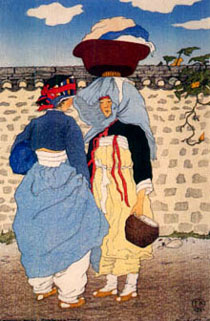
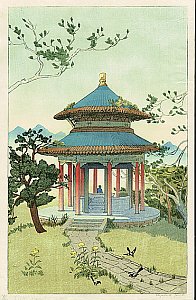
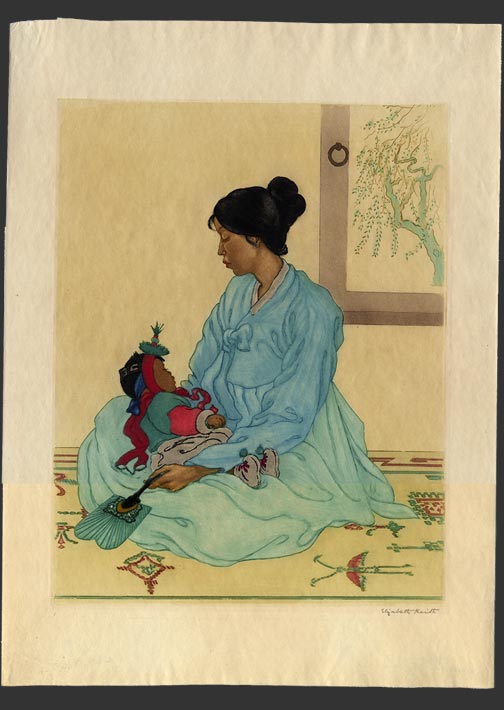 Woodblock printing is a technique for printing text, images or patterns used widely throughout East Asia and originating in China in antiquity as a method of printing on textiles and later paper.
Woodblock printing is a technique for printing text, images or patterns used widely throughout East Asia and originating in China in antiquity as a method of printing on textiles and later paper.
Woodcut—formally known as xylography—is a relief printing artistic technique in printmaking in which an image is carved into the surface of a block of wood, with the printing parts remaining level with the surface while the non-printing parts are removed, typically with gouges. The areas to show 'white' are cut away with a knife or chisel, leaving the characters or image to show in 'black' at the original surface level. The block is cut along the grain of the wood (unlike wood engraving where the block is cut in the end-grain). In Europe beechwood was most commonly used; in Japan, a special type of cherry wood was used. The surface is covered with ink by rolling over the surface with an ink-covered roller (brayer), leaving ink upon the flat surface but not in the non-printing areas.
The Ukiyo-e artists favored cherry wood for their wood block prints because it was soft and easy to carve. The artist’s drawing was chiseled and carved on wood blocks, one block for each color. Each block was applied to a piece of paper separately until the image was completed. It was a multi-step process including the artist, engraver, printer and finally publisher.
Tom & Alana Campbell 5214 South 2nd Avenue, Everett, Washington 98203-4113 Telephone (425) 252-2981
